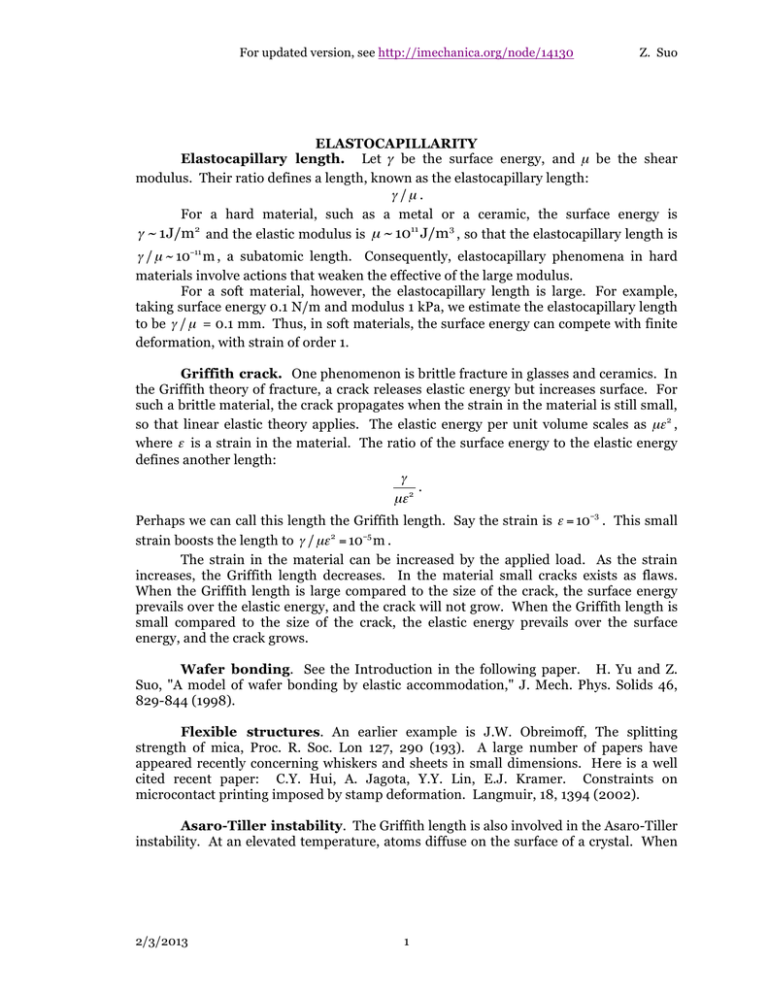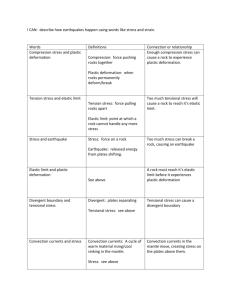γ µ
advertisement

For updated version, see http://imechanica.org/node/14130 Z. Suo ELASTOCAPILLARITY Elastocapillary length. Let γ be the surface energy, and µ be the shear modulus. Their ratio defines a length, known as the elastocapillary length: γ /µ . For a hard material, such as a metal or a ceramic, the surface energy is γ ~ 1J/m2 and the elastic modulus is µ ~ 1011 J/m 3 , so that the elastocapillary length is γ / µ ~ 10−11 m , a subatomic length. Consequently, elastocapillary phenomena in hard materials involve actions that weaken the effective of the large modulus. For a soft material, however, the elastocapillary length is large. For example, taking surface energy 0.1 N/m and modulus 1 kPa, we estimate the elastocapillary length to be γ / µ = 0.1 mm. Thus, in soft materials, the surface energy can compete with finite deformation, with strain of order 1. Griffith crack. One phenomenon is brittle fracture in glasses and ceramics. In the Griffith theory of fracture, a crack releases elastic energy but increases surface. For such a brittle material, the crack propagates when the strain in the material is still small, so that linear elastic theory applies. The elastic energy per unit volume scales as µε 2 , where ε is a strain in the material. The ratio of the surface energy to the elastic energy defines another length: γ . µε 2 Perhaps we can call this length the Griffith length. Say the strain is ε = 10−3 . This small strain boosts the length to γ / µε 2 = 10−5 m . The strain in the material can be increased by the applied load. As the strain increases, the Griffith length decreases. In the material small cracks exists as flaws. When the Griffith length is large compared to the size of the crack, the surface energy prevails over the elastic energy, and the crack will not grow. When the Griffith length is small compared to the size of the crack, the elastic energy prevails over the surface energy, and the crack grows. Wafer bonding. See the Introduction in the following paper. H. Yu and Z. Suo, "A model of wafer bonding by elastic accommodation," J. Mech. Phys. Solids 46, 829-844 (1998). Flexible structures. An earlier example is J.W. Obreimoff, The splitting strength of mica, Proc. R. Soc. Lon 127, 290 (193). A large number of papers have appeared recently concerning whiskers and sheets in small dimensions. Here is a well cited recent paper: C.Y. Hui, A. Jagota, Y.Y. Lin, E.J. Kramer. Constraints on microcontact printing imposed by stamp deformation. Langmuir, 18, 1394 (2002). Asaro-Tiller instability. The Griffith length is also involved in the Asaro-Tiller instability. At an elevated temperature, atoms diffuse on the surface of a crystal. When 2/3/2013 1 For updated version, see http://imechanica.org/node/14130 Z. Suo the crystal is under stress, atoms can diffuse on the surface to make a smooth surface rough. The surface energy and elastic energy compete in this instability. The surface tends to make the surface smooth, while the elastic energy tends to make the surface rough. When the wavelength of the perturbation of the surface is large compared to the Griffith length, the elastic energy prevails over the surface energy, and instability sets in. The Asaro-Tiller instability has been used to make self-assembled quantum dots. Creep void and sintering. See beginning lectures on evolving small structures (http://imechanica.org/node/4868). γ . σ This length may be called the Laplace length. Surface stress. See a lecture (http://imechanica.org/node/4865). number of papers exist on the effect of surface stress in elastic solids. A large Finite Deformation We next formulate a theory of elastocapillarity in soft materials. These notes assume that you have learned the basics of finite deformation (http://imechanica.org/node/538). Free energy. Consider a body undergoing an isothermal, homogeneous deformation. The deformation is specified by the deformation gradient F. The size of the body is so large that the effect of the surface is negligible. Define the nominal density of the Helmholtz free energy by Helmholtz freeenergy of the body incurrent state W= volumeof the body inreferencestate Because the deformation is homogeneous, the nominal density of the free energy is the same for all material particles in the body. The elasticity of the material is specified by prescribing the nominal density of the free energy as a function of the deformation gradient: W =W F . ( ) Next consider a body of a finite size. In the reference state, the volume of the body is V, the surface area of the body is A, and the Helmholtz free energy is set to be zero. Material particles in the interior of the body behave differently from material particles on the surface of the body. But let us still consider a nearly homogeneous deformation in that material particles a few molecules away from the surface undergo a homogeneous deformation. In the current state, the Helmholtz free energy of the body is written as Helmholtz freeenergy of the body incurrent state = WV + ΓA . Here we define the nominal density of the surface energy Γ as the free energy of the body in excess of that volumetric energy. In the current state, the surface area of the body is a. We can also write the surface energy of the body as 2/3/2013 2 For updated version, see http://imechanica.org/node/14130 Z. Suo ΓA = γ a where γ is the surface energy divided by the surface area of the body in the current state. Liquid-like behavior. To specify the material model, we also need to describe how the surface energy changes with deformation. Here I will focus on a model likely to be applicable to soft materials such as elastomers and elastomeric gels. An elastomer is a network of long molecules, crosslinked by covalent bonds. Each long molecule consists of a large number of monomers. When the elastomer is stretched, the area of the surface increases. This increase of the surface area is due to molecules moving from the interior of the body to the surface of the body. This behavior is the same as that of a liquid. In this idealized model, the surface energy of the body is proportional of the surface area of the body—that is, the true density of the surface energy, γ , is a constant independent of the deformation. We will use this liquid-like model in the subsequent development. Contraction of a thin sheet. When the size of a body is large, the effect of the surface energy is negligible. Consider a large body under no external load. This state is taken to be the reference state. We now cut a thin sheet from the large body. The surface energy will motivate the sheet to reduce in area, but the elasticity will resist the contraction. The two competing actions cause the thin sheet to reach a state of equilibrium. This state is the current state. In the reference state, the thickness of the sheet is H and the lateral dimensions are L and L. In the current state, the three dimensions become h, l and l. The material is taken to be incompressible, so that HL2 = hl 2 . Define the lateral stretch as λ = l / L . The −2 stretch in the thickness direction is h / H = λ . () The nominal density of elastic energy is a function of the lateral stretch, W λ . 2 2 The surface energy of the sheet scales with the area of the deformed sheet, 2γ l = 2γ L λ 2 . Consequently, the free energy of the sheet is W λ HL2 + 2γ L2 λ 2 . () When the sheet contracts, λ < 1 , the surface energy decreases, and the elastic energy increases. The state of equilibrium minimizes this total free energy. Consequently, the stretch in the current state is determined by ( ) H + 4γλ = 0 . dW λ dλ This equation characterizes the state of equilibrium. As an example, assume that the material obeys the neo-Hookean model: µ W λ = 2λ 2 + λ −4 − 3 . 2 The stretch in the state of equilibrium is ( ) 2/3/2013 ( ) 3 For updated version, see http://imechanica.org/node/14130 Z. Suo −1/6 ! 2γ $ λ =# +1 & . " Hµ % This stretch is measurable is the elastocapillary length is much larger than the thickness of the sheet, γ / µ >> H . Exercise. Interpret the equilibrium equation in terms of the balance between the elastic stress and the surface tension. Exercise. Determine the state of equilibrium of a thin rod. Go over this exercise using both by minimizing the free energy and by balancing forces. The balance of forces is more interesting in this case because the surface tension also causes a hydrostatic compression in the rod. Inhomogeneous deformation. Consider a body in three dimensions. When the body is in the reference state, a material particle occupies a place whose coordinate is X. When the body deforms to the current state, and the material particle X moves to a place whose coordinate is x. The deformation of the body is described by x=x X . ( ) The domain of this function is the coordinates of material particles when the body is in the reference state. The range of this function is the coordinates of the places occupied by the material particles. Deformation gradient is given by ∂xi X . FiK = ∂X K ( ) ( ) ( ) The field F X is the gradient of the field of deformation x X . Free energy. When a body undergoes an inhomogeneous deformation, the free energy of the body is given by ∫ W F dV + γ 1a1 + γ 2a2 +... ( ) Several types of the surfaces might be involved. For example, when a liquid drop is on a substrate of a soft elastic solid, three surfaces are present: the surface of the liquid, the surface of the substrate, and the interface between the liquid and the surface. If external loads are applied, one may also add the potential energy due to the external load. One can construct a composite system, such that the composite interacts with the surroundings by heat transfer. The composite reaches equilibrium when the Helmholtz free energy of the composite is minimized. For example, assume that the body is subject to a weight P. The potential energy of the weight is −Pl , where l is the displacement at the place where the weight is applied. The body and the weight together form a composite system. The free energy of the composite system is a sum of the free energy of the body and the potential energy of the weight: 2/3/2013 4 For updated version, see http://imechanica.org/node/14130 ∫ W (F) dV + γ a + γ a 1 1 2 2 Z. Suo +...− Pl . The state of equilibrium minimizes this total free energy. Equilibrium at a triple junction. At triple junction, when three surfaces meet, the angles between the surfaces are determined by the well-known expressions that balance the surface tension. R.W. Style and E.R. Dufresne, Static wetting on deformable substrates, from liquids to soft solids. Soft Matter 8, 7177 (2012). Change of surface area. A relation in geometry: δa = ∫ Kni δ xi da , where the mean curvature is related to the principal radii of the surface: 1 1 K= + R1 R2 The curvature can be calculated from the current shape of the surface. Condition of equilibrium in differential equations. The condition of equilibrium can also be stated in a differential form. The change in the free energy equals the work done by the external forces: ∫ δW dV + γδa = ∫ Ti δ xi dA . The left-hand side is the change in the free energy of the body. Here for simplicity, we only describe one surface. In the right-hand side, Ti is the nominal traction. The work ∫ t δ x da . can also be written in terms of true traction, i i Recall that the nominal stress and deformation gradient are work-conjugate, and the in equilibrium, for each material element, the change in the free energy equals the work done: δW = siK δ FiK . We write ∫ δW dV = ∫ siK δ FiK dV = ∫ siK δ xi,K dV = ∫ #% siK δ xi $ ( = ∫s iK ) ,K − siK ,K δ xi &(dV ' N K δ xi dA − ∫ siK ,K δ xi dV The last equation invokes the divergence theorem. Also recall the relation between the nominal stress and the true stress σ ij = siK F jK / J , and the relation between the areas in the reference state and the current state, FiK ni da = JN K dA . The condition of equilibrium becomes that − ∫ siK ,K δ xi dV + ∫ #$ σ ij + γ K δij n j − ti %&δ xi da = 0 . ( 2/3/2013 ) 5 For updated version, see http://imechanica.org/node/14130 Z. Suo The condition of equilibrium holds for arbitrary changes of the field of deformation, δ xi . Consequently, the above condition of equilibrium is equivalent to siK ,K = 0 in the interior of the body, and (σ ij ) + γ K δij n j = ti on the surface of the body. These conditions of equilibrium should be combined with the balance of the surface tensions at triple junctions. Cavitation in a soft elastic solid. See the following paper. S. Kundu, A. J. Crosby, Cavitation and Fracture Behavior of Polyacrylamide Hydrogels. Soft Matter 5, 425-431 (2009). This paper demonstrates the "cavitation rheology"—the use of cavitation as a technique to determine elastic modulus of a soft material. The technique enables the determination of modulus of a small part of a tissue, beneath the surface. The surface energy of the cavity plays a significant role in this technique. Rayleigh instability of an elastic rod. See a description of the Rayleigh instability of a liquid jet (http://imechanica.org/node/4858). Similar instability is expected in a soft elastic solid. One might even imagine wrinkles at the edge of a thin sheet of a soft material. I will describe the results when they are ready. For recent papers on elastocapillarity in soft materials, see iMechanica journal club, theme of February 2013 led by Shengqiang Cai (http://imechanica.org/node/14119). 2/3/2013 6







